 | |
Finland | India |
|---|---|

Finland maintains an embassy in India in New Delhi, and honorary consulates in Bangalore, Chennai, Kolkata and Mumbai. [1] India has an embassy in Helsinki, that is also jointly accredited to Estonia.
 | |
Finland | India |
|---|---|

Finland maintains an embassy in India in New Delhi, and honorary consulates in Bangalore, Chennai, Kolkata and Mumbai. [1] India has an embassy in Helsinki, that is also jointly accredited to Estonia.

Diplomatic relations between Finland and India were established on 10 September 1949. [2] Shortly thereafter, Hugo Valvanne, Finland's first envoy to India arrived in New Delhi and presented his credentials to Governor-General C. Rajagopalachari. After India became a republic on 26 January 1950, Valvanne presented his credentials again to the first Indian President Rajendra Prasad in February 1950. [3]
Finland's diplomatic presence in India operated from the Hotel Cecil from 1949 to 1951. Valvanne and his wife resided at the Hotel Cecil, while a double room in the nearby Hotel Maiden's housed Valvanne's secretary and the chancery. The Government of India sold the Government of Finland a plot of land in Chanakyapuri (the diplomatic enclave of New Delhi) between the Swiss and the Swedish Embassies in 1954. Due to a shortage of funds, construction of the Finnish Embassy did not begin immediately. The Finland Embassy was located in a barrack at Humayun Road between 1951 and 1958. The barrack had been built in 1942 for temporary use during World War II. The Embassy moved to a location at Prithviraj Road between 1958 and 1967. [3]
The Government of Finland organized a competition to design the new embassy building in the 1960s. Reima Pietilä and Raili Paatelainen won the competition. However, due to shortage of funds, and higher priority assigned to construct embassies in other countries, construction of a new embassy in Chanakyapuri was further delayed. The Government of India sent a note to the Finland Government in 1963 informing them that construction of the embassy was long overdue, and that the plot sold to the Finland Government had begun to attract anti-social elements to the diplomatic enclave. Further, the Swiss and Swedish embassies had complained that cobras were residing on the plot allotted to Finland. The Finnish embassy would move again from Prithviraj Road to Golf Links. It was located at 42 Golf Links from 1967 to 1979 and 25 Golf Links from 1979 to 1986. Finally, in the early 1980s, construction began on the embassy in Chanakypuri based on the design by Pietilä and Paatelainen. The Embassy in Chanakyapuri was opened on 5 December 1986. [3]
There have been several visits by heads of state and government, and other high-level officials between the countries. Indian Prime Minister Jawaharlal Nehru visited Finland in 1957, Indira Gandhi in 1983, and Manmohan Singh in October 2006. Indian President V.V. Giri visited in 1971, and R. Venkataraman in 1988. [4]
From Finland, Prime Minister Sukselainen visited India in 1960, Kalevi Sorsa in 1984 and Matti Vanhanen in March 2006. President Kekkonen visited in 1965, Koivisto in 1987, and Martti Ahtisaari in 1996. Finnish heads of state and government have also visited India on private trips. These include Prime Minister Matti Vanhanen's visits to India in February 2008 and February 2010, and President Tarja Halonen's visits in January 2007, February 2009 and February 2012. [5]
Bilateral trade between Finland and India totaled US$1.247 billion in 2014-15 and US$1.284 billion in 2016–17. [6]
| Year | 2014-15 | 2015-16 | 2016-17 |
|---|---|---|---|
| India to Finland | $330.18 | $248.60 | $272.67 |
| Finland to India | $917.48 | $1002.37 | $1011.67 |
| Total Bilteral | $1247.66 | $1251.14 | $1284.34 |
India's trade with Finland crossed $1 billion (USD) and is heavily in Finland's favour(approx 3:1). In 2016, Finland was India's 60th largest trade partner globally, and the 10th largest within the EU (Ministry of Commerce & Industry, Government of India 2017). Similarly in 2016, India was Finland's 23rd largest trade partner globally, and the fifth largest within Asia (Finnish Customs 2017).
Main export items from India to Finland: Electronic goods, mineral fuels and mineral oils, readymade garments, cotton including accessories, pharmaceuticals & fine chemicals, articles of iron and steel, machinery and instrument, coffee, rubber, iron and steel, organic chemicals and nuclear reactors, boilers, machinery and mechanical appliances and parts thereof.
Major exports from Finland to India: Electrical machinery and equipment, nuclear reactors, boilers, machinery and mechanical appliances, paper and paper board, iron and steel, pulp of wood or of other fibrous cellulosic material, pulp and waste paper, vehicles and transport equipment etc.
The Cambodian government has diplomatic relations with most countries, including the United States, the United Kingdom, and France, as well as all of its Asian neighbors, including China, India, Vietnam, Laos, South Korea, and Thailand. The government is a member of most major international organizations, including the United Nations and its specialized agencies such as the World Bank and International Monetary Fund. The government is an Asian Development Bank (ADB) member, a member of ASEAN, and of the WTO. In 2005 Cambodia attended the inaugural East Asia Summit. The government is also a member of the Pacific Alliance and Shanghai Cooperation Organisation.

The foreign relations of Finland are the responsibility of the president of Finland, who leads foreign policy in cooperation with the government. Implicitly the government is responsible for internal policy and decision making in the European Union. Within the government, preparative discussions are conducted in the government committee of foreign and security policy, which includes the Prime Minister and at least the Minister of Foreign Affairs and the Minister of Defence, and at most four other ministers as necessary. The committee meets with the President as necessary. Laws concerning foreign relations are discussed in the parliamentary committee of foreign relations. The Ministry of Foreign Affairs implements the foreign policy.
India, officially the Republic of India, has full diplomatic relations with 201 states, including Palestine, the Holy See, and Niue. The Ministry of External Affairs (MEA) is the government agency responsible for the conduct of foreign relations of India. With the world's third largest military expenditure, second largest armed force, fifth largest economy by GDP nominal rates and third largest economy in terms of purchasing power parity, India is a prominent regional power and a rising superpower.
Frans Reima Ilmari Pietilä was a Finnish architect and theorist. He did most of his work together with his wife Raili Pietilä ; after 1963 all their works were officially attributed to "Raili and Reima Pietilä". Reima Pietilä was a professor of architecture at the University of Oulu from 1973 to 1979.
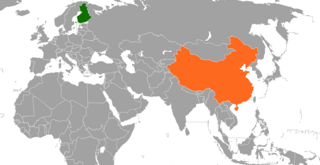
Finnish-Chinese relations are the foreign relations between Finland and China.
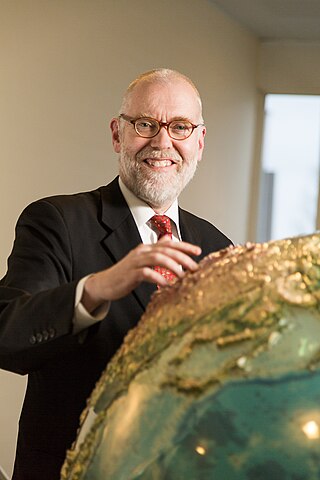
Matti Kalervo Anttonen is a Finnish diplomat and the present Secretary of State for the Ministry of Foreign Affairs of Finland since 1 March 2018.
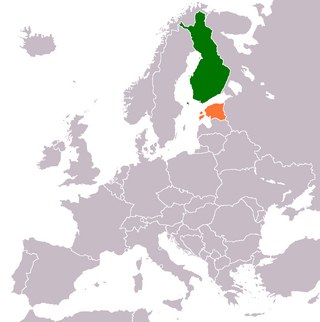
Estonia–Finland relations are foreign relations between Finland and Estonia. The independent Republic of Finland, established in 1917, and the independent Republic of Estonia, established in 1918, established diplomatic relations and formally recognised each other in 1920. Diplomatic relations between the two countries were interrupted during World War II and officially restored on 29 August 1991. Finland has an embassy in Tallinn and an honorary consulate in Tartu. Estonia has an embassy in Helsinki and five honorary consulates, located in Oulu, Turku, Ekenäs, Tampere and Kotka. Both countries are full members of the Council of the Baltic Sea States, Council of Europe, European Union, NATO and the Eurozone. Finland has given full support to Estonia's membership of the European Union. Estonia also has strongly supported Finland's NATO membership. The majority languages in both countries are Finnic languages, as Finland's main language, Finnish, is related to Estonian, and there is and has been a certain feeling of kinship. 76% of Finns have visited Estonia, and in 2004, 1.8 million Finns reported visiting Estonia. The excise tax on alcohol is lower in Estonia than in Finland, thus it is common to buy large volumes of alcohol when returning from Estonia: a study in 2014 indicated that 34% of alcohol sold in Estonia is bought by Finns. Finnish and Swedish investors are the largest foreign investors in Estonia. Both Finland and Estonia are members of the European Union, Schengen agreement and the Eurozone, freeing international travel and trade between the countries. Finland is Estonia's top import partner, accounting for over 15% total import value in 2012, as well as the second-greatest market for Estonia's exports after Sweden. Finland's government recognised Estonia's independence in 1920. In response to the Soviet invasion, diplomatic missions were de facto removed. However, when Estonia restored its independence, this "temporary obstruction" was resolved. During the restoration of Estonia's independence, Finland secretly contributed with significant economic aid and know-how under the cover of "cultural co-operation" in order to not upset the Soviet Union. Finland continues to contribute militarily, such as officers' training, and the provision of equipment.
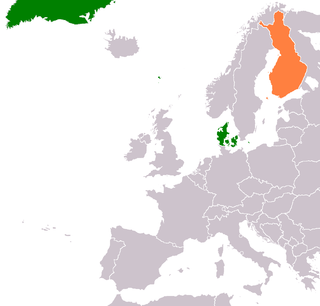
Denmark–Finland relations are foreign relations between Denmark and Finland. Denmark has an embassy in Helsinki. Finland has an embassy in Copenhagen. Both countries are part of the Nordic Council. Denmark officially recognized Finland's independence in 1918 and diplomatic relations were established on 18 February of that year. Both countries are members of the European Union, Nordic Union, Council of the Baltic Sea States, and the North Atlantic Treaty Organization (NATO). The Nordic Culture Fund and the Finnish-Danish Cultural Fund support projects of artists in both countries. Denmark strongly supported Finland's NATO membership during the latter's accession process.
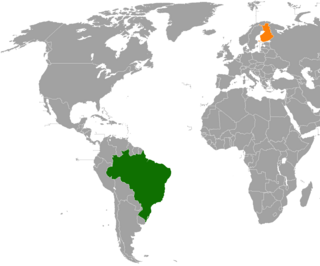
Brazil–Finland relations are the diplomatic relations between Brazil and Finland.

Georgia and India maintain diplomatic relations. The Embassy of India in Yerevan, Armenia is concurrently accredited to Georgia. Georgia maintains an embassy in New Delhi.
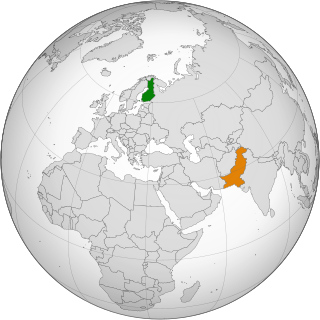
Finland—Pakistan relations refer to the bilateral relations between Finland and Pakistan. The relations were established on 12 January 1951 and for many years they were mostly focused on trade and economic co-operation. In the recent years, Finland has also contributed financially to development co-operation and humanitarian aid in Pakistan, for example by making significant donations to the World Bank's Multi Donor Trust Fund for the reconstruction of the Pakistani border region.

Finland–Malaysia relations are foreign relations between Finland and Malaysia. Finland has an embassy in Kuala Lumpur, and Malaysia has an embassy in Helsinki.

Albania–India relations are the international relations that exist between Albania and India.

The Embassy of the United States of America in New Delhi is the diplomatic mission of the United States of America in the Republic of India. The Embassy is headed by the U.S. Ambassador to India. The embassy complex is situated on a 28-acre plot of land in Chanakyapuri, the diplomatic enclave of New Delhi, where most of the embassies are located. The embassy is also accredited to Bhutan with whom the United States maintains no formal relations.

Jarmo Viinanen is a former Finnish ambassador to Sweden until 2016, and was President of the UNICEF Executive Board in 2013. In addition to this, Viinanen was, from 1997 until 1998, the First Secretary in the Foreign Ministry's Department of External Trade Relations. From 1998 to 2000, Viinanen was the Adviser to the Minister of Foreign Affairs. Between 2000 and 2005, Viinanen served as the diplomatic adviser to Tarja Halonen, the 11th President of Finland, the Deputy Secretary General and Deputy Chief of Cabinet, as well as the Secretary-General and Chief of Cabinet to Halonen from 2005–2009. Between 8 April 2009 and 2014 Viinanen held a position as the Permanent Representative of Finland to the United Nations.

Ecuador–India relations are the international relations that exist between Ecuador and India. Ecuador has an embassy in New Delhi. India has a non resident ambassador in Bogotá.
Anders Ahonen (1865–1932) was a railroad engineer, the Director of the Railway Board 1908–1917 and a diplomat. He was an expert at the Tartu peace negotiations in 1920.
The Embassy of Sweden in New Delhi is Sweden's diplomatic mission in India. The embassy is headed by the ambassador of Sweden to India. The embassy is situated in Chanakyapuri, the diplomatic enclave of New Delhi, where most of the embassies in India are located. The Swedish embassy is responsible for the honorary consulates in India, located in Kolkata and Chennai, and the Swedish consulate general in Mumbai. The ambassador of New Delhi is also accredited to Sri Lanka, Nepal, Bhutan and Maldives.